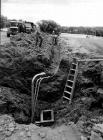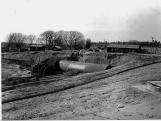1
The construction of the Diefenbunker was commissioned by Prime Minister John Diefenbaker in 1959. Constructing CFS Carp (nicknamed the Diefenbunker) was part of a plan called the "Continuity of Government Program". This program was developped by the Canadian Government and was to be implemented in the event of a nuclear attack. Facilities known as Emergency Government Headquarters were developed in secret across the country. CFS Carp - also known as the Central Emergency Government Headquarters - would house elements of the Canadian Government, including the Prime Minister and Governor General, in lockdown for 30 days in the event of a nuclear attack. The men and women designated to come here would be responsible for governing the country from the safety of this top secret underground facility.Construction of the Diefenbunker was completed on-time and on-budget. It took nearly 14 months to build the entire 100,000 square foot underground bunker. Constructing the Diefenbunker is reputed to have cost over $22 million, which is the equivalent of approximately $170.9 million in todays dollar. Over 1000 workers were involved in the construction of this unique military base.
Carp was selected as the location for this facility for a couple of reasons. First, it was close enough to Ottawa to provide refuge in a short amount of time, but far enough away from downtown Ottawa to avoid a direct hit. The second reason was Canada's westerly prevailing winds. These winds would carry the nuclear fallout from an attack on Ottawa to the East and away from Carp.
Construction of the Diefenbunker was extremely top secret. Men working on the construction of this underground facility did not know the full extent of what they were building, and they were not supposed to share details of the construction with anybody else.
3
At 75 feet underground, the bunker contains 32,000 cubic yards of concrete and over 5000 tons of steel. The building was designed to withstand a nuclear blast equivalent to 5 million tons of TNT. The facility was designed hold 535 people in lockdown for 30 days. These 535 people would not allowed to go outside for any reason during lockdown. The bunker is equiped with: an operating theatre and fully functioning hospital, a fully stocked cafeteria, and a suite for both the Prime Minister and Governor General as a result. The Diefenbunker was also equipped with a CBC broadcasting studio room which would be used to make announcements to the civilian population, and the Bank of Canada Vault, which would hold all of Canada's gold in the event of a nuclear attack.5
The bunker's construction used over 3 times the amount of reinforcing steel usually used in the construction of concrete buildings. Construction of the Diefenbunker was very carefully planned. Thirty-six specially designed steel and concrete columns create the main structure of the bunker. The concrete on the outer walls is 5-feet thick.6
Detail of Support Columns and Rebarcirca late 1961 or early 1962
CFS Carp, Carp, Ontario, Canada
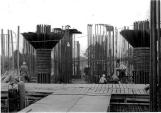 Credits:
Credits:Diefenbunker Archives
7
The Diefenbunker was designed and constructed by the Foundation Company of Canada, a company based out of Montreal. The Department of National Defence and Canada Emergency Measures Organization supervised the planning and construction of the bunker. The bunker is 100,000 sqaure feet. Each side of the bunker is approximately 157 feet long.8
View of Construction Progresscirca 1961
CFS Carp, Carp, Ontario, Canada
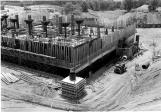 Credits:
Credits:Diefenbunker Archives
9
The Blast Tunnel was an important part of the construction of the Diefenbunker. This 378-foot long tunnel was designed to divert the force of an explosion away from the main doors. The thinking was that the force of an explosion would carry all the way through the tunnel and exit out on top of the hill, leaving the Diefenbunker and it's main doors unharmed, even if the tunnel itself was destroyed.10
Construction of Blast Tunnelcirca 1961/1962
CFS Carp, Carp, Ontario, Canada
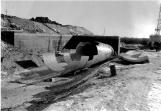 Credits:
Credits:Diefenbunker Archives

